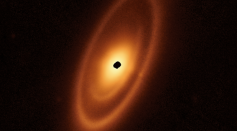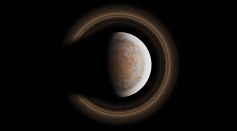Tags: Exoplanets
Aliens May Be Using Greenhouse Gases to Make Planets or Exoplanets Habitable
Breaking News: Earth Confirmed as Inhabited! LIFE Telescope Simulation Sets Stage for Epic Exoplanet Discoveries
Search for Possible Alien Tech: 'Mathematically Perfect' HD 110067 Star System Undergoes Investigation

JWST's Glimpse into the Future: Predicting Solar System's Fate through Exoplanet Observations

Next-Gen Telescopes To Analyze Exoplanet Atmospheres for Biosignatures That Can Provide Evidence for Extraterrestrial Life

NASA Finds Six 'Sub-Neptune' Exoplanets in an Extraordinary Celestial Symphony Around Their Star
Bouncing Comets Deliver Molecular Building Blocks for Life on Earth, Could Do the Same to Exoplanets
NASA's Kepler Telescope Data Unveils a Planetary System With Seven Hot, Large Exoplanets

Rare Image Reveals Exoplanets Colliding 1,800 Light-Years Away, Offering Insights into Infrared Surges and Stellar Dimming

Nearly 50% of Rocky Exoplanets Revealed as 'Burning Worlds' with Lava Oceans: Study Explores Their Impact on Super-Earths
Powerful Magnetic Fields of Cool Stars Could Render Exoplanets Uninhabitable, Study Reveals
Trojan Planets Co-Existing in the Same Orbit Spotted After Being Hypothesized for 20 Years
Exoplanets With Frozen Surfaces May Have Oceans Beneath Their Icy Shells To Host Extraterrestrial Life [Study]

Multiple Tatooine Worlds From Same Star System Picked Up For the Second Time; What Are These Planets?

Hot Jupiters May Not Always Be Alone: New Research Challenges Isolation Assumption, Unveils Surprising Exoplanet Companions

Tidal Extremes From Dwarf Stars Could Sterilize Two-Thirds of Planets But Hundreds of Millions May Still Harbor Life While in the Habitable Zone

Star 15 Times Brighter Than the Sun Captured in the New Images Shared by NASA's James Webb Space Telescope

New Search Criteria for Extraterrestrial Life Based on 'Computational Zones,' Astronomers Proposed

Killer Moons Might Be Crashing on Their Host Planets, Wiping Out Chances of Life to Survive

Extraterrestrial Life Potentially Exists in the 'Terminator Zone' of Distant Exoplanets, Study Suggests
Most Popular

Largest Known Volcanic Aquifer Discovered Beneath Oregon's Cascades

New 'Supergiant' Sea Bug Found in South China Sea, Named After Darth Vader

Mediterranean Sea Was Refilled by a Catastrophic Flood Millions of Years Ago

Mysterious Cosmic Waves That Sound Like Birds Detected in Unexpected Space Region





